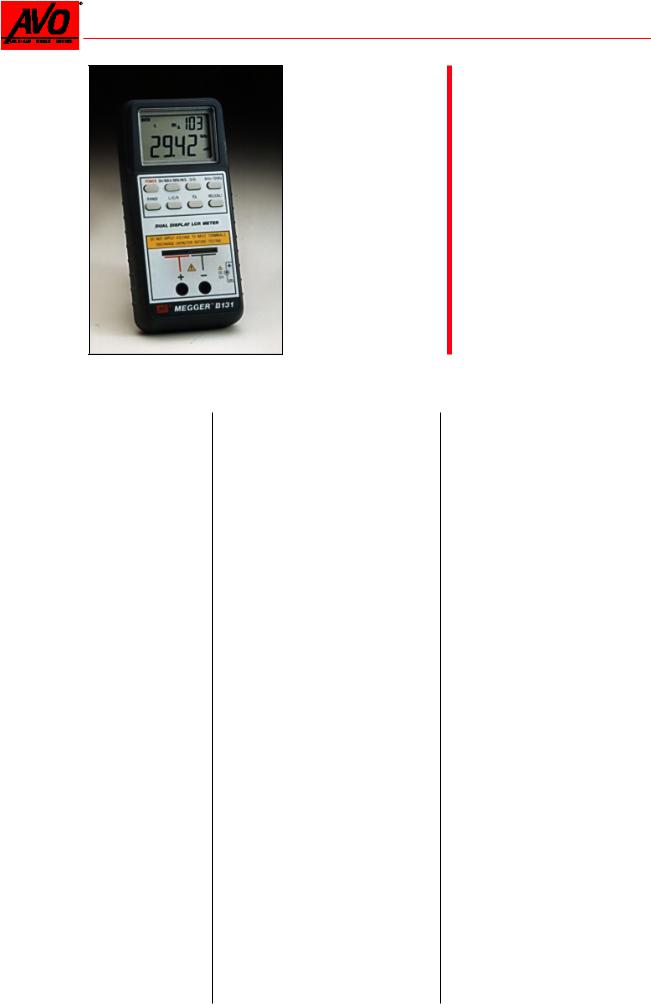Avo b131 User Manual

AVO INTERNATIONAL
AVO® MEGGER®
B131
• Dual Display, Dual -
Parameter Measurements
• 0,5% Basic Accuracy
• Parallel/Series Mode
• Relative Mode for Deviation Measurement
Universal LCR Meter
DESCRIPTION
The Model B131 Universal LCR Meter is a portable instrument designed for quick, easy testing and analysing of discrete components in a broad range of applications. The unit will accurately measure the value of inductances, capacitances and resistances at frequencies of 120 Hz and 1 kHz.
The B131 provides a high 0,5% average accuracy and is capable of measuring electrolytic / ceramic capacitors, transformers, filter coils, speaker coils as well as standard LCR components. Additionally the instrument has many special features which have been incorporated for a variety of differing applications.
Dual Display
The unique Dual Display allows the meter to simultaneously display both the numerical L/C/R values as well as D/Q (dissipation/quality) factor of any inductance or capacitance measurement. A secondary display can be set to show component values in terms of percentage when the tolerance mode is activated, as well as the status of Parallel or Series mode data.
Dual-Frequency
It is important for the user to test and evaluate components at similar measuring frequencies to the components’ actual operating frequencies. The B131 LCR meter provides two of the most commonly used test frequencies 120 Hz and 1 kHz to simulate the actual component application condition. For example, a voice coil is generally rated at 1 kHz whereas power circuit applications are rated at 120 Hz.
Parallel/Series Mode
The B131 LCR meter is capable of showing all the measured values in series or parallel equivalent circuits. The parallel mode is the default for capacitance and resistance measurements and the series mode is the default for inductance measurement.
Tolerance Mode
The tolerance modes are 1%, 5% and 10% respectively for the Inductance, Capacitance and Resistance functions. This feature has been designed for fast convenient component sorting, removing the necessity of the user having to take readings each time a new component is being measured. Once the tolerance mode has been selected, the meter will indicate a single “beep” for a component in tolerance and three consecutive “beeps” for components out of tolerance.
Static Recording
The Static Recording Function provides convenient statistical information when measuring bundles of components either in tape and reel or bulk packing. When testing a batch of similar components the values can automatically be stored into memory. Calculations are then performed in the static recording mode and the display will indicate the maximum value, the minimum value and the average value of the batch of components. An ideal feature when company quality procedures require routine or continuous testing of components during incoming goods inspection.
Calibration
This function is performed to calibrate the meter internally at both the upper and lower limits of each range. It will also calibrate externally to compensate for connector residues present whilst using test leads.
Relative Mode
This function is useful for value correlation and component comparison applications. By pressing the “REL” key the display will be set to zero, storing the present reading as the reference value. All subsequent readings in terms of their plus or minus value with comparison to the original stored value are then displayed.
APPLICATIONS
The instrument can be used in the Autorange or Manual mode and is designed for measuring the value of discrete components. It is suited for use in field service applications and for laboratory or repair workshop requirements. Equally the advance features make it invaluable for batch checking of components in quality assurance and inspection situations. As well as measuring standard component parameters, the B131 can be used as a component analyser for determining the Q and D factors.
